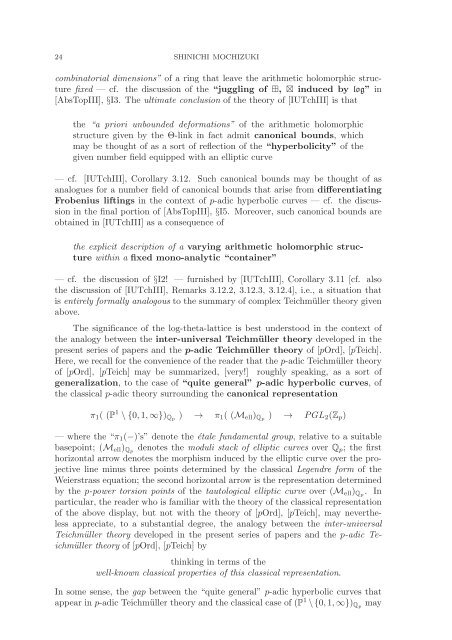Inter-universal Teichmuller Theory I: Construction of Hodge Theaters
Inter-universal Teichmuller Theory I: Construction of Hodge Theaters
Inter-universal Teichmuller Theory I: Construction of Hodge Theaters
Create successful ePaper yourself
Turn your PDF publications into a flip-book with our unique Google optimized e-Paper software.
24 SHINICHI MOCHIZUKI<br />
combinatorial dimensions” <strong>of</strong> a ring that leave the arithmetic holomorphic structure<br />
fixed — cf. the discussion <strong>of</strong> the “juggling <strong>of</strong> ⊞, ⊠ induced by log” in<br />
[AbsTopIII], §I3. The ultimate conclusion <strong>of</strong> the theory <strong>of</strong> [IUTchIII] is that<br />
the “a priori unbounded deformations” <strong>of</strong> the arithmetic holomorphic<br />
structure given by the Θ-link in fact admit canonical bounds, which<br />
may be thought <strong>of</strong> as a sort <strong>of</strong> reflection <strong>of</strong> the “hyperbolicity” <strong>of</strong> the<br />
given number field equipped with an elliptic curve<br />
— cf. [IUTchIII], Corollary 3.12. Such canonical bounds may be thought <strong>of</strong> as<br />
analogues for a number field <strong>of</strong> canonical bounds that arise from differentiating<br />
Frobenius liftings in the context <strong>of</strong> p-adic hyperbolic curves — cf. the discussion<br />
in the final portion <strong>of</strong> [AbsTopIII], §I5. Moreover, such canonical bounds are<br />
obtained in [IUTchIII] as a consequence <strong>of</strong><br />
the explicit description <strong>of</strong> a varying arithmetic holomorphic structure<br />
within a fixed mono-analytic “container”<br />
— cf. the discussion <strong>of</strong> §I2! — furnished by [IUTchIII], Corollary 3.11 [cf. also<br />
the discussion <strong>of</strong> [IUTchIII], Remarks 3.12.2, 3.12.3, 3.12.4], i.e., a situation that<br />
is entirely formally analogous to the summary <strong>of</strong> complex Teichmüller theory given<br />
above.<br />
The significance <strong>of</strong> the log-theta-lattice is best understood in the context <strong>of</strong><br />
the analogy between the inter-<strong>universal</strong> Teichmüller theory developedinthe<br />
present series <strong>of</strong> papers and the p-adic Teichmüller theory <strong>of</strong> [pOrd], [pTeich].<br />
Here, we recall for the convenience <strong>of</strong> the reader that the p-adic Teichmüller theory<br />
<strong>of</strong> [pOrd], [pTeich] may be summarized, [very!] roughly speaking, as a sort <strong>of</strong><br />
generalization, to the case <strong>of</strong> “quite general” p-adic hyperbolic curves, <strong>of</strong><br />
the classical p-adic theory surrounding the canonical representation<br />
π 1 ((P 1 \{0, 1, ∞}) Qp ) → π 1 ((M ell ) Qp ) → PGL 2 (Z p )<br />
—wherethe“π 1 (−)’s” denote the étale fundamental group, relative to a suitable<br />
basepoint; (M ell ) Qp denotes the moduli stack <strong>of</strong> elliptic curves over Q p ; the first<br />
horizontal arrow denotes the morphism induced by the elliptic curve over the projective<br />
line minus three points determined by the classical Legendre form <strong>of</strong> the<br />
Weierstrass equation; the second horizontal arrow is the representation determined<br />
by the p-power torsion points <strong>of</strong> the tautological elliptic curve over (M ell ) Qp . In<br />
particular, the reader who is familiar with the theory <strong>of</strong> the classical representation<br />
<strong>of</strong> the above display, but not with the theory <strong>of</strong> [pOrd], [pTeich], may nevertheless<br />
appreciate, to a substantial degree, the analogy between the inter-<strong>universal</strong><br />
Teichmüller theory developed in the present series <strong>of</strong> papers and the p-adic Teichmüller<br />
theory <strong>of</strong> [pOrd], [pTeich] by<br />
thinking in terms <strong>of</strong> the<br />
well-known classical properties <strong>of</strong> this classical representation.<br />
In some sense, the gap between the “quite general” p-adic hyperbolic curves that<br />
appear in p-adic Teichmüller theory and the classical case <strong>of</strong> (P 1 \{0, 1, ∞}) Qp may
















